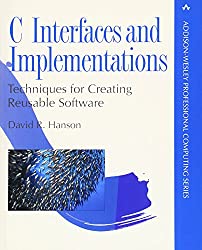“C Interfaces And Implementations” is a book by David R Hanson that shows you how to create interfaces and their corresponding implementations in the C programming language in a way that minimizes the coupling between a module and its clients, while enforcing a well-defined contract. The author demonstrates this by building a small library of useful data-structures and helper-fuctions that is freely available under a liberal license.
The book starts off by explaining what literate programming is and how it uses the Noweb tool for literate programming to interweave source-code and explanatory text. It then describes what an interface is, how the implementation needs to be separated from the interface, and the general technique followed by the book to declare interfaces and define the implementations. The rest of the book describes the interfaces and implementations of various widely-applicable modules, repeatedly demonstrating the techniques shown in the first couple of chapters. In the process, it also reveals interesting information about the C programming language and its standard library that even experienced programmers would benefit from.
C provides minimal support for defining interfaces via declarations and for
implementations via the corresponding definitions. Unlike many other high-level
programming languages, especially of recent vintage, it does not provide support
for namespaces, exceptions, garbage-collection, concurrency, etc. On top of
that, its standard library is quite minimal, providing no support for common
data-structures, and is littered with footguns like strcat() for
the careless programmer. For any non-trivial project in C, programmers have had
to roll up their own helper-libraries to tide over these shortcomings or use an
external library like GLib.
This book helps the former category of programmers in their endeavor and
provides an alternative minimal library for the latter category of programmers.
To minimize the coupling between a module and its clients, the modules in this book present their interface in a header-file using the bare minimum information required to link against that module. In particular, for an Abstract Data-Type (ADT), only an opaque pointer is exposed to clients, so that implementations for the corresponding interface can be switched without affecting the clients. Since C does not provide support for namespaces, all structures and functions in the interface of a module have the name of the module as a prefix in their names.
For example, for a module providing a “Snafu” ADT, the
snafu.h header-file would look something like:
#ifndef SNAFU_INCLUDED
#define SNAFU_INCLUDED
#define T Snafu_T
typedef struct Snafu_T *T;
extern T Snafu_new(void);
extern void Snafu_wombat(T s);
extern void Snafu_free(T *s);
#undef T
#endif /* SNAFU_INCLUDED */
Thus the client only works with the opaque Snafu_T (aliased to the
short-hand T in the interface, but not otherwise exposed to
clients, for reducing the noise). The implementation is then free to define
struct Snafu_T however it pleases and manage its memory however it
wants. The implementation can even be swapped out according to the requirements
without affecting the client-code (e.g. for performing extensive checks for
memory-safety in a memory-management module at the cost of performance, instead
of the usual lightweight checks). The interface extensively documents the
contract between the client and the module. The implementation performs various
checks, including using assert(), to verify this contract when its
functions are called. (As an aside, note how Snafu_free() takes a
pointer to a pointer instead of just a pointer in order to minimize
double-frees by overwriting the original pointer.)
The author builds up a library of useful data-structures and helpful functions using this technique. These include data-structures like stacks, lists, hash-tables, strings, etc. and helper-functions for working with arithmetic beyond what is provided by the language, error-handling, memory-management, concurrency, etc. As is evident from the (extensive) bibliographic references and the background of the author, these interfaces are inspired by the corresponding interfaces in Icon and its predecessor SNOBOL. The implementations in this book (from 1997) might not be terribly cache-friendly on modern CPUs, so they should not be used as is if you care about performance.
I am in two minds about the use of literate programming in this book. On the one hand, it is quite distracting to put together the implementation of a function scattered across a chapter. On the other hand, it might be helpful to some readers to break the monotony of a wall of code by interspersing it with descriptive text. I personally prefer to see all of the code for a function together in one place.
Many experienced C-programmers have been using the techniques shown in this book in their own code, so the book would be good for them to get a refresher on a disciplined approach to create such APIs in C. For inexperienced C-programmers, there is a wealth of information here about improving their usage of the language and avoiding the many, many footguns it presents to the unsuspecting programmer. For most applications these days, C is not the right programming language to use for the implementation, but when you have to program in C, it helps to have a great resource at hand like this book (and Expert C Programming).
